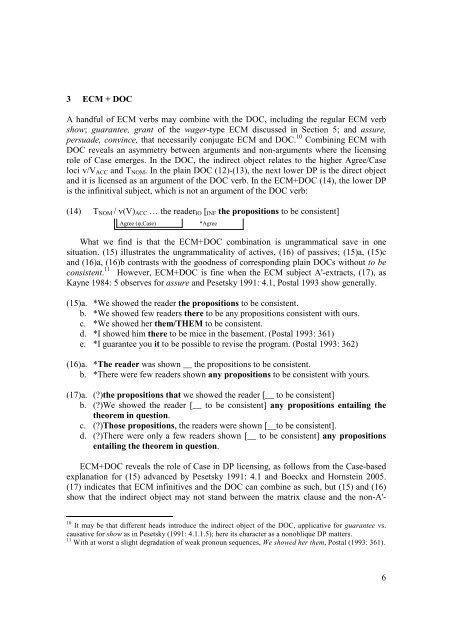Case Filter - UMR 7023 - CNRS
Case Filter - UMR 7023 - CNRS
Case Filter - UMR 7023 - CNRS
Create successful ePaper yourself
Turn your PDF publications into a flip-book with our unique Google optimized e-Paper software.
3 ECM + DOC<br />
A handful of ECM verbs may combine with the DOC, including the regular ECM verb<br />
show; guarantee, grant of the wager-type ECM discussed in Section 5; and assure,<br />
persuade, convince, that necessarily conjugate ECM and DOC. 10 Combining ECM with<br />
DOC reveals an asymmetry between arguments and non-arguments where the licensing<br />
role of <strong>Case</strong> emerges. In the DOC, the indirect object relates to the higher Agree/<strong>Case</strong><br />
loci v/V ACC and T NOM . In the plain DOC (12)-(13), the next lower DP is the direct object<br />
and it is licensed as an argument of the DOC verb. In the ECM+DOC (14), the lower DP<br />
is the infinitival subject, which is not an argument of the DOC verb:<br />
(14) T NOM / v(V) ACC … the reader IO [ INF the propositions to be consistent]<br />
Agree (φ,<strong>Case</strong>)<br />
*Agree<br />
What we find is that the ECM+DOC combination is ungrammatical save in one<br />
situation. (15) illustrates the ungrammaticality of actives, (16) of passives; (15)a, (15)c<br />
and (16)a, (16)b contrasts with the goodness of corresponding plain DOCs without to be<br />
consistent. 11 However, ECM+DOC is fine when the ECM subject A'-extracts, (17), as<br />
Kayne 1984: 5 observes for assure and Pesetsky 1991: 4.1, Postal 1993 show generally.<br />
(15)a. *We showed the reader the propositions to be consistent.<br />
b. *We showed few readers there to be any propositions consistent with ours.<br />
c. *We showed her them/THEM to be consistent.<br />
d. *I showed him there to be mice in the basement. (Postal 1993: 361)<br />
e. *I guarantee you it to be possible to revise the program. (Postal 1993: 362)<br />
(16)a. *The reader was shown __ the propositions to be consistent.<br />
b. *There were few readers shown any propositions to be consistent with yours.<br />
(17)a. (?)the propositions that we showed the reader [__ to be consistent]<br />
b. (?)We showed the reader [__ to be consistent] any propositions entailing the<br />
theorem in question.<br />
c. (?)Those propositions, the readers were shown [__to be consistent].<br />
d. (?)There were only a few readers shown [__ to be consistent] any propositions<br />
entailing the theorem in question.<br />
ECM+DOC reveals the role of <strong>Case</strong> in DP licensing, as follows from the <strong>Case</strong>-based<br />
explanation for (15) advanced by Pesetsky 1991: 4.1 and Boeckx and Hornstein 2005.<br />
(17) indicates that ECM infinitives and the DOC can combine as such, but (15) and (16)<br />
show that the indirect object may not stand between the matrix clause and the non-A'-<br />
10 It may be that different heads introduce the indirect object of the DOC, applicative for guarantee vs.<br />
causative for show as in Pesetsky (1991: 4.1.1.5); here its character as a nonoblique DP matters.<br />
11 With at worst a slight degradation of weak pronoun sequences, We showed her them, Postal (1993: 361).<br />
6

















